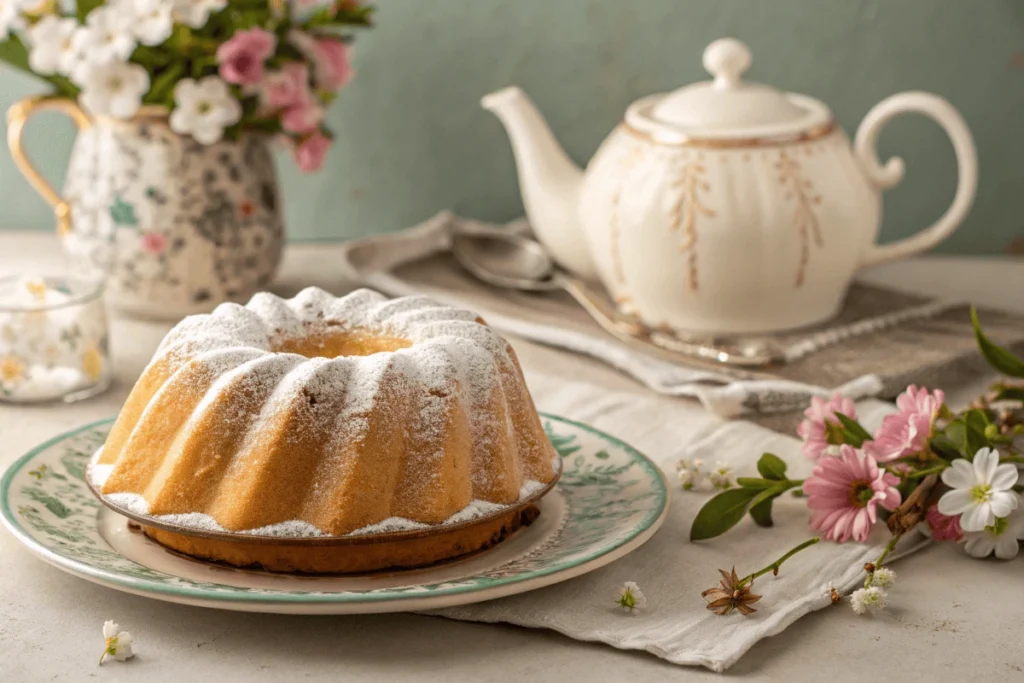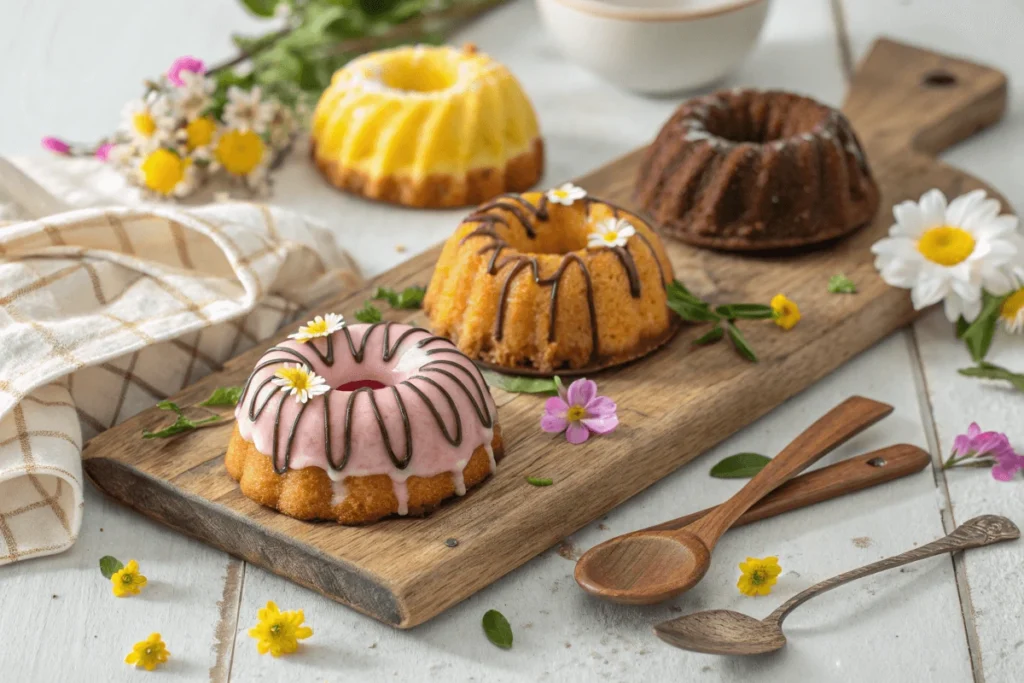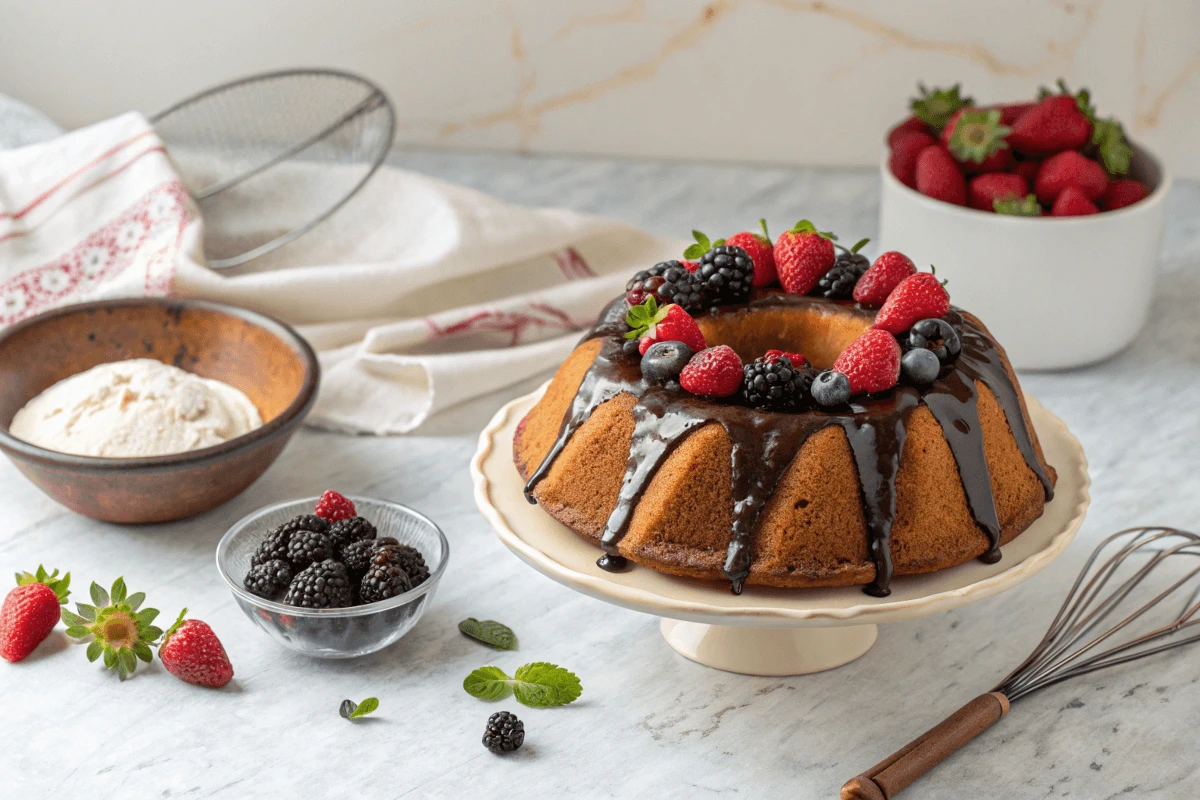Donut-shaped cakes have captured the hearts (and taste buds) of dessert lovers worldwide. From their strikingly symmetrical rings to their soft, flavorful insides, these cakes offer both aesthetic appeal and mouthwatering goodness. But what exactly are these cakes called? Depending on where you are, names like Bundt cakes, gugelhupf, and savarin might spring to mind. In this article, we’ll unravel the intriguing history, types, and techniques behind these delectable creations.
From understanding the origins of the iconic Bundt cake to exploring international variations, this guide dives deep into all things donut-shaped cakes. We’ll also share baking tips, decorating ideas, and healthy twists to keep your creations fresh and unique. Let’s begin!
Introduction to Donut Shaped Cakes
What Defines a Donut Shaped Cake?
A donut-shaped cake is a baked dessert with a distinctive ring or circular shape and a hollow center. In fact, the hole in the middle serves a purpose—it helps the cake bake evenly by allowing more surface area to absorb the heat. As a result, this feature keeps the cakes light, moist, and consistent in texture.
This design spans cultures and cuisines, with each region adding its unique twist. For example, the U.S. popularized Bundt cakes, while Europe brought us the elegant gugelhupf. Ultimately, across the globe, these cakes celebrate symmetry and elegance.
A Brief History of Donut Shaped Cakes
The history of the donut-shaped cake goes back many years. European bakers, especially in Germany and Austria, made the gugelhupf—a yeasted cake baked in a fluted, ring-shaped pan. This recipe led to many changes over time, finally creating the modern Bundt cake, which became popular in the 20th century.
The Bundt pan, made famous by Nordic Ware in the 1950s, gave this style a big boost in the U.S. when a Bundt cake recipe won second place in the 1966 Pillsbury Bake-Off. Since then, these cakes have stayed a classic favorite, loved for their flexibility and beautiful looks.
Popular Names and Variants Around the World
Depending on the region, these cakes go by many names. In France, the savarin reigns supreme, often soaked in syrup for added sweetness. Germans cherish the gugelhupf, typically flavored with nuts and dried fruits. Meanwhile, modern bakers in the U.S. and beyond have taken creative liberties, introducing flavors like chocolate, lemon, and pumpkin.
No matter what it’s called, the donut-shaped cake remains a dessert staple, marrying beauty with practicality. Its unique ring design continues to capture imaginations in kitchens worldwide.
Common Names for Donut Shaped Cakes
Bundt Cake: The Most Recognizable Name
When people ask, “What is a donut-shaped cake called?”, most immediately think of the Bundt cake. Nordic Ware popularized the term with their unique pan design, which features a fluted edge and a hole in the center. Drawing inspiration from the European gugelhupf, they patented the pan in the mid-20th century and made the Bundt cake a hallmark of American baking.
Bundt cakes showcase incredible versatility, forming the base for countless recipes, including lemon drizzle, chocolate fudge, and pumpkin spice. Their distinctive ring shape not only adds visual appeal but also promotes even baking, delighting bakers everywhere.
Krantz Cakes, Kugelhopf, and Other Regional Variants
While Bundt cakes dominate in America, other cultures have their own donut-shaped desserts. In Germany and Austria, the kugelhopf is a yeasted cake, often filled with nuts or dried fruit. Similarly, the French savarin is a light, syrup-soaked cake, perfect for pairing with fresh cream or fruit.
Modern adaptations have introduced a wide variety of ingredients and flavors, blending tradition with innovation. Whether it’s a classic Bundt or an exotic ring cake, these desserts continue to capture hearts worldwide.
The Evolution of Bundt Cakes
How Bundt Cakes Got Their Name
The name “Bundt” derives from the German word bund, which refers to a gathering or group. This etymology reflects the cake’s traditional role as a centerpiece for communal celebrations. The Bundt pan, designed by Nordic Ware in the 1950s, added the distinctive fluted edge that we now associate with these cakes.
The turning point for Bundt cakes came in 1966 when a Bundt pan recipe secured second place in the Pillsbury Bake-Off, skyrocketing the cake’s popularity.
The Role of Nordic Ware in Popularizing the Bundt Pan
Nordic Ware’s innovative aluminum pan transformed how cakes were baked and presented. Moreover, its ability to create perfectly even cakes with a decorative edge captured bakers’ imaginations. Over time, the brand expanded its offerings with pans featuring intricate patterns, thus turning ordinary cakes into edible art.
Cultural Significance of Bundt Cakes
From potlucks to weddings, Bundt cakes have become a symbol of shared joy. Their adaptability ensures that they suit almost any occasion. Whether you’re savoring a rich chocolate Bundt or a zesty lemon creation, the appeal of this donut-shaped cake lies in its balance of form and function.
Learn more about unique takes on Bundt cakes and their decorations in LivelyCook’s Donut Cake Guide.
Types of Donut Shaped Cakes Across Cultures
European Varieties: Gugelhupf, Savarin, and Pannetone
Europe has long celebrated the beauty of donut-shaped cakes. The Gugelhupf, originating from Germany and Austria, features a light, yeasted dough often enriched with nuts and dried fruits. Similarly, the Savarin, hailing from France, is a syrup-soaked dessert baked in a ring mold and frequently adorned with whipped cream and berries.
The Italians add their flair with Pannetone, a festive bread-cake hybrid often baked in a rounded mold that mirrors the iconic donut shape. While the Pannetone isn’t always baked in a ring form, some regional versions incorporate this design to celebrate special occasions.

Asian Influences: Ring Cakes and Mochi Bundt Cakes
Asia offers its own take on the donut-shaped cake. Japanese bakers have innovated with mochi Bundt cakes, marrying the chewy texture of mochi with the aesthetics of a Bundt mold. In the Philippines, puto ring cakes—steamed rice cakes shaped in rings—are a popular dessert during celebrations.
The global influence of donut-shaped cakes has fostered cross-cultural fusion, creating desserts that cater to both traditional and modern tastes.
Modern Innovations in Donut Shaped Cakes
In today’s kitchens, donut-shaped cakes come in countless forms. From gluten-free adaptations to trendy matcha and salted caramel flavors, bakers have reimagined these cakes to fit contemporary preferences. Silicone and patterned Bundt pans have also given rise to intricate designs, proving that creativity has no bounds when answering the question, What is a donut shaped cake called?
Baking a Donut Shaped Cake at Home
Essential Tools and Ingredients
To bake the perfect donut-shaped cake, start with the right tools. A fluted or ring-shaped pan, such as a Bundt pan, is non-negotiable. Ensure it’s well-greased to avoid sticking. Other essentials include mixing bowls, a whisk, and a spatula.
Ingredients depend on your recipe, but most include flour, sugar, eggs, butter, and leavening agents. To achieve a moist crumb, consider adding sour cream, yogurt, or even buttermilk.
Step-by-Step Recipe for a Classic Bundt Cake
- Prepare the Pan: Grease the Bundt pan thoroughly and dust it with flour.
- Mix the Batter: Combine wet ingredients (butter, sugar, eggs) in one bowl and dry ingredients (flour, baking powder, salt) in another. Gradually mix the two together.
- Pour and Bake: Pour the batter evenly into the pan and bake at 350°F (175°C) for 40-50 minutes, or until a toothpick comes out clean.
- Cool and Release: Let the cake cool for 10 minutes before gently inverting it onto a wire rack.
Tips and Tricks for Perfecting the Donut Shape
- Tap the pan lightly to remove air bubbles before baking.
- Rotate the cake halfway through baking for even cooking.
- Allow ample cooling time to avoid breaking the cake during release.
For a creative twist, try drizzling a zesty lemon glaze or sprinkling powdered sugar on top. This classic Bundt recipe is the perfect introduction to baking your own donut-shaped cake. For more baking ideas, check out LivelyCook’s Donut Cake Guide.
Differences Between Bundt Cakes and Other Cakes
Shape and Structure
One of the most striking differences between Bundt cakes and other cakes is their signature ring shape. Unlike layer cakes or loaf cakes, a Bundt cake is defined by its fluted sides and hollow center. This unique design isn’t just for looks—it helps the cake bake evenly by allowing heat to circulate through the center. If someone asks, What is a donut shaped cake called?, the Bundt cake is the answer that stands out for its functionality and beauty.
Other cakes, like sheet cakes or traditional round cakes, lack this built-in heating advantage. The shape also makes Bundt cakes a standout dessert centerpiece at gatherings.
Flavor Profiles and Ingredient Choices
Bundt cakes tend to be denser and richer than other cakes, often featuring ingredients like sour cream, buttermilk, or oil to enhance moisture. Their recipes are versatile, accommodating flavors like chocolate, lemon, or even savory ingredients, making them a go-to for creative bakers.
Traditional cakes, on the other hand, often use light and fluffy batters, perfect for stacking and layering with frostings. Bundt cakes are typically single-layered, with their intricate shapes eliminating the need for elaborate decoration.
Use of Specialty Pans
What sets a Bundt cake apart is its reliance on a specially designed pan. In addition, these pans come in various shapes and patterns, elevating the cake’s aesthetic appeal. On the other hand, other cakes don’t depend on such pans, therefore making Bundt cakes a unique example of how the mold shapes the experience.
Creative Decorating Ideas for Donut Shaped Cakes
Glazing and Frosting Techniques
Decorating a donut-shaped cake opens up endless possibilities. A simple glaze—like a classic vanilla or chocolate drizzle—can highlight the fluted edges, enhancing the cake’s design. For added flair, try a two-tone glaze or a marbled effect.
If you’re aiming for something more indulgent, opt for a rich buttercream frosting. Piping it into the grooves of the cake adds texture and makes the design pop. You can also dust powdered sugar over the top for a minimalist, elegant finish.
Incorporating Seasonal Themes
Seasonal ingredients and decorations are a fun way to customize your donut-shaped cake. For a winter-inspired cake, use peppermint glaze and sprinkle crushed candy canes. In spring, try a lemon glaze with edible flowers. Autumn calls for pumpkin spice flavors and caramel drizzles, while summer cakes can feature fresh berries and citrus zests.
Edible Toppings and Add-ons
Toppings like crushed nuts, shredded coconut, or chocolate shavings add texture and flavor to your cake. You can even take inspiration from donut toppings—such as sprinkles or cinnamon sugar—to create a playful twist.
The key to decorating these cakes lies in accentuating their shape. Since the ring design already draws attention, even simple decorations can transform your donut-shaped cake into a showstopper.

Healthier Options for Donut Shaped Cakes
Using Whole Grain Flours and Natural Sweeteners
Health-conscious bakers don’t have to miss out on the joy of a donut-shaped cake. By swapping all-purpose flour for whole-grain or almond flour, you can boost the cake’s fiber and nutrient content. Additionally, replacing refined sugar with natural alternatives like honey, maple syrup, or coconut sugar provides sweetness with fewer processed ingredients.
Bundt cakes, often perceived as indulgent, can still be flavorful without relying on heavy fats and sugars. These small changes make the dessert both satisfying and nourishing.
Low-Fat and Gluten-Free Variants
For those trying to lower their fat intake, ingredients like Greek yogurt or applesauce work well as replacements for butter or oil. These changes make cakes moist and soft without adding extra calories. Gluten-free flours like rice, oat, or tapioca flour can also meet dietary needs without losing flavor.
Many people ask, What is a donut shaped cake called? and wonder how it fits into a healthier lifestyle. By using these options, you can enjoy Bundt cakes without guilt.
Portion Control for Smaller Donut Shaped Treats
Using mini Bundt pans or individual molds allows for better portion control. Smaller servings make it easier to indulge without overdoing it, especially when trying healthier recipes. These bite-sized versions are perfect for sharing or enjoying on the go.
FAQs and Fun Facts About Donut Shaped Cakes
Why Are Bundt Cakes Called Bundt Cakes?
The name “Bundt” comes from the German word bund, meaning a group or gathering. The pan’s special shape and fame made Bundt cakes closely tied to celebrations.
What Is the Most Popular Flavor for Donut Shaped Cakes?
Classic flavors like chocolate and lemon are still top choices, but seasonal ones like pumpkin spice and apple cinnamon have become more popular.
Can You Make Savory Donut Shaped Cakes?
Yes, you can! Savory versions, like cornbread Bundt cakes or cheese-filled ring cakes, are becoming more common. They go great with soups and stews, adding a fun twist to the usual cake.
What Makes Donut Shaped Cakes Unique Compared to Cupcakes?
Donut-shaped cakes, especially Bundt cakes, stand out for their detailed designs and moist texture. Unlike cupcakes, their beauty often comes from the pan rather than frosting or decorations.
For more tips and creative ideas, explore LivelyCook’s Donut Cake Guide.


1 thought on “What is a donut shaped cake called?”